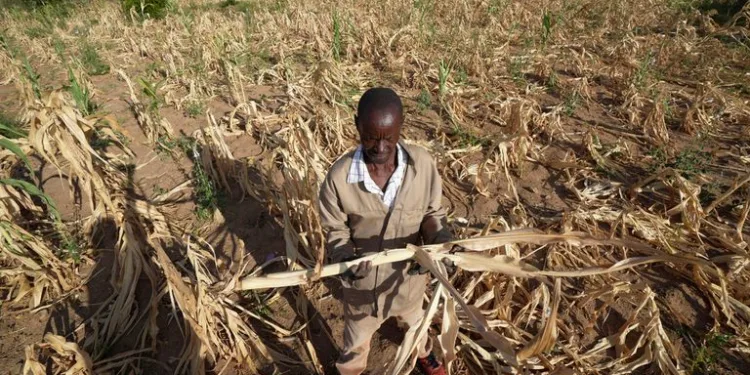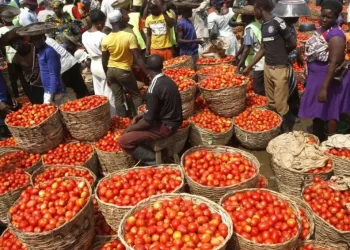Zimbabwe’s drought will leave millions of people hungry as the year (2024) progresses.
President Emmerson Mnangagwa of Zimbabwe, on Wednesday, April 3, 2024, declared drought as a national disaster, a development that underscores the severity of the situation.
Noting that millions of people in the country would face food insecurity, Mnangagwa told journalists in Harare that at least, 2.7 million people in the country would go hungry this year (2024) due to Zimbabwe’s drought.
Zimbabwe in the Grip of Drought
A severe drought has gripped Zimbabwe, threatening millions with food insecurity. The government recently declared the drought a national disaster, highlighting the urgency of the situation. This crisis is a result of a confluence of factors, posing a major challenge for the nation.
Erratic rainfall patterns, a hallmark of climate change, have left farmlands parched and crops withered. The El Nino phenomenon, known for causing dry spells in southern Africa, has intensified the drought’s impact. Additionally, years of economic mismanagement and limited investment in water infrastructure have hampered Zimbabwe’s ability to cope with the crisis.
Also Read: Ramadan: Niger Republic Struggles With Food Inflation
The consequences of the drought are dire. Agricultural production, the cornerstone of Zimbabwe’s economy, has plummeted. Maize, the country’s staple food, is in short supply, with prices skyrocketing beyond the reach of many households. Livestock, a vital source of protein and income for rural communities, are also suffering, dying from thirst and lack of adequate grazing land.
The most vulnerable populations – children, pregnant women, and the elderly – are bearing the brunt of the crisis. Malnutrition rates are rising, particularly among children, who are susceptible to stunting and other health complications. The World Food Programme (WFP) estimates that over 4.4 million people, a quarter of the rural population, will require food assistance in the coming months, a significant increase from previous projections.
How the drought is affecting people’s wellbeing in Zimbabwe
The situation has grown critical since November, with most provinces experiencing crop failure. Hotter regions have already written off staple grains like maize, a stark symbol of the crisis severity.
This drought is not a singular event, but a confluence of factors creating a perfect storm. Erratic rainfall patterns, a hallmark of climate change, have left farmlands parched. The El Nino phenomenon, infamous for causing dry spells in southern Africa, has amplified the drought’s impact. Adding to this are years of economic mismanagement and limited investment in water infrastructure, significantly hindering Zimbabwe’s ability to cope with the crisis.
The consequences are dire. Agricultural production, the lifeblood of the economy, has plummeted. Maize, the cornerstone of Zimbabwean diets, is in short supply, forcing prices to skyrocket beyond the reach of many households. The crisis doesn’t stop there. Livestock, a vital source of protein and income for rural communities, are succumbing to thirst and lack of grazing land. Hunger is taking its toll on the most vulnerable – children, pregnant women, and the elderly. Malnutrition rates are rising, particularly among children who face the threat of stunting and other debilitating health complications.
The World Food Programme (WFP) paints a grim picture. They estimate that over 4.4 million people, a quarter of the rural population, will desperately need food assistance in the coming months. This is a significant increase from previous projections, highlighting the rapid deterioration of the food security situation. Humanitarian agencies, including the WFP, who provided food aid to 270,000 people in four districts between January and March, are calling the situation “dire” and urging donors to increase their aid contributions.
However, Zimbabwe is not alone in its struggle. The drought has reached crisis levels across southern Africa. Neighboring countries like Botswana and Angola to the west, and Mozambique and Madagascar to the east, are also facing severe hunger. This regional challenge necessitates a coordinated international response to prevent a full-blown famine.
The Zimbabwean government’s recent declaration of the drought a national disaster opens doors for increased resource allocation and international aid. However, the effectiveness of this response will depend heavily on ensuring transparency and tackling past issues of mismanagement. Additionally, long-term solutions beyond immediate relief are crucial. Investing in climate-smart agriculture, such as drought-resistant crops and improved water management practices, is essential for building resilience. Strengthening rural infrastructure and diversifying the economy beyond agriculture can further empower communities to face future challenges with greater strength.
Zimbabwe stands at a crossroads. The immediate task is to alleviate hunger and prevent a humanitarian catastrophe. However, the nation must also seize this opportunity to build a more robust and sustainable food system, one that can withstand the shocks and uncertainties of a changing climate. The time for action is now, as the future food security of millions hangs in the balance.










